An Assessment of the Temperature and Humidity of Atmospheric Infrared Sounder (AIRS) v6 Profiles Using Radiosonde Data in the Lee of the Tibetan Plateau
Abstract
1. Introduction
2. Data and Methods
2.1. Data
2.2. Methods
3. Results
3.1. Vertical Profile Comparisons
3.2. Horizontal Comparisons
3.3. Comparison of PWV
3.4. Comparison of Daytime and Nighttime Products
3.5. Comparison of AO Data between Two Periods
3.6. Impact of QC Levels on AIRS Data
4. Discussions and Conclusions
Author Contributions
Funding
Acknowledgments
Conflicts of Interest
References
- Wu, G.; Liu, Y.; He, B.; Bao, Q.; Duan, A.; Jin, F. Thermal controls on the Asian summer monsoon. Sci. Rep. 2012, 2, 404. [Google Scholar] [CrossRef] [PubMed]
- Rajagopalan, B.; Molnar, P. Signatures of Tibetan Plateau heating on Indian summer monsoon rainfall variability. J. Geophys. Res. Atmos. 2013, 118, 1170. [Google Scholar] [CrossRef]
- Xu, X.; Lu, C.; Ding, Y.; Shi, X.; Guo, Y.; Zhu, W. What is the relationship between China summer precipitation and the change of apparent heat source over the Tibetan Plateau? Atmos. Sci. Lett. 2013, 14, 227–234. [Google Scholar] [CrossRef]
- Li, Y.; Li, D.; Yang, S.; Liu, C.; Zhong, A.; Li, Y. Characteristics of the precipitation over the eastern edge of the Tibetan Plateau. Meteorol. Atmos. Phys. 2010, 106, 49–56. [Google Scholar] [CrossRef]
- Wang, Y.; Wang, L.; Li, X.; Chen, D. Temporal and spatial changes in estimated near-surface air temperature lapse rates on Tibetan Plateau. Int. J. Climatol. 2018, 38, 2907–2921. [Google Scholar] [CrossRef]
- Zhao, Y.; Xu, X.; Zhao, T.; Yang, X. Effects of the Tibetan Plateau and its second staircase terrain on rainstorms over North China: From the perspective of water vapour transport. Int. J. Climatol. 2019, 39, 1–13. [Google Scholar] [CrossRef]
- Qian, T.; Zhao, P.; Zhang, F.; Bao, X. Rainy-season precipitation over the Sichuan basin and adjacent regions in Southwestern China. Mon. Wea. Rev. 2015, 143, 383–394. [Google Scholar] [CrossRef]
- Cheng, X.; Li, Y.; Xu, L. An analysis of an extreme rainstorm caused by the interaction of the Tibetan Plateau vortex and the Southwest China vortex from an intensive observation. Meteorol. Atmos. Phys. 2016, 128, 373–399. [Google Scholar] [CrossRef]
- Yu, S.; Gao, W.; Xiao, D.; Peng, J. Observational facts regarding the joint activities of the southwest vortex and plateau vortex after its departure from the Tibetan Plateau. Adv. Atmos. Sci. 2016, 33, 34–46. [Google Scholar] [CrossRef]
- Li, L.; Zhang, R.; Wen, M. Genesis of southwest vortices and its relation to Tibetan Plateau vortices. Q. J. R. Meteorol. Soc. 2017, 143, 2556–2566. [Google Scholar] [CrossRef]
- McNally, A.P.; Watts, P.D.; Smith, J.A.; Engelen, R.; Kelly, G.A.; Thépaut, J.N.; Matricardi, M. The assimilation of AIRS radiance data at ECMWF. Q. J. R. Meteorol. Soc. 2006, 132, 935–957. [Google Scholar] [CrossRef]
- Raju, A.; Parekh, A.; Kumar, P.; Gnanaseelan, C. Evaluation of the impact of AIRS profiles on prediction of Indian summer monsoon using WRF variational data assimilation system. J. Geophys. Res. Atmos. 2015, 120, 8112–8131. [Google Scholar] [CrossRef]
- Zheng, J.; Li, J.; Schmit, T.J.; Li, J.; Liu, Z. The impact of AIRS atmospheric temperature and moisture profiles on hurricane forecasts: Ike (2008) and Irene (2011). Adv. Atmos. Sci. 2015, 32, 319–335. [Google Scholar] [CrossRef]
- Pan, F.; Huang, X.; Leroy, S.S.; Lin, P.; Strow, L.L.; Ming, Y.; Ramaswamy, V. The stratospheric changes inferred from 10 years of AIRS and AMSU-A radiances. J. Clim. 2017, 30, 6005–6016. [Google Scholar] [CrossRef]
- Wang, X.; Jiang, H. A 13-year global climatology of tropical cyclone warm-core structures from AIRS data. Mon. Wea. Rev. 2019, 147, 773–790. [Google Scholar] [CrossRef]
- Fetzer, E.J.; Lambrigtsen, B.H.; Eldering, A.; Aumann, H.H.; Chahine, M.T. Biases in total precipitable water vapor climatologies from atmospheric infrared sounder and advanced microwave scanning radiometer. J. Geophys. Res. 2006, 111. [Google Scholar] [CrossRef]
- Yue, Q.; Fetzer, E.J.; Kahn, B.H.; Wong, S.; Manipon, G.; Guillaume, A.; Wilson, B. Cloud-state-dependent sampling in AIRS observations based on cloudsat cloud classification. J. Clim. 2013, 26, 8357–8377. [Google Scholar] [CrossRef]
- Boylan, P.; Wang, J.; Cohn, S.A.; Fetzer, E.; Maddy, E.S.; Wong, S. Validation of AIRS version 6 temperature profiles and surface-based inversions over Antarctica using Concordiasi dropsonde data. J. Geophys. Res. Atmos. 2015, 120, 992–1007. [Google Scholar] [CrossRef]
- Divakarla, M.G.; Barnet, C.D.; Goldberg, M.D.; McMillin, L.M.; Maddy, E.; Wolf, W.; Zhou, L.; Liu, X. Validation of atmospheric infrared sounder temperature and water vapor retrievals with matched radiosonde measurements and forecasts. J. Geophys. Res. 2006, 111. [Google Scholar] [CrossRef]
- Zeng, Z.; Mao, F.; Wang, Z.; Guo, J.; Gui, K.; An, J.; Yim, S.H.L.; Yang, Y.; Zhang, B.; Jiang, H. Preliminary evaluation of the atmospheric infrared sounder water vapor over China against high-resolution radiosonde measurements. J. Geophys. Res. Atmos. 2019, 124, 3871–3888. [Google Scholar] [CrossRef]
- Zhou, T.; Yu, R.; Chen, H.; Dai, A.; Pan, Y. Summer precipitation frequency, intensity, and diurnal cycle over China: A comparison of satellite data with rain gauge observations. J. Clim. 2008, 21, 3997–4010. [Google Scholar] [CrossRef]
- Susskind, J.; Blaisdell, J.M.; Iredell, L. Improved methodology for surface and atmospheric soundings, error estimates, and quality control procedures: The atmospheric infrared sounder science team version-6 retrieval algorithm. J. Appl. Remote Sens. 2014, 8, 84994. [Google Scholar] [CrossRef]
- Aumann, H.H.; Chahine, M.T.; Gautier, C.; Goldberg, M.D.; Kalnay, E.; McMillin, L.M.; Revercomb, H.; Rosenkranz, P.W.; Smith, W.L.; Staelin, D.H.; et al. AIRS/AMSU/HSB on the aqua mission: Design, science objectives, data products, and processing systems. IEEE Trans. Geosci. Remote Sens. 2003, 41, 253–264. [Google Scholar] [CrossRef]
- Chahine, M.T.; Pagano, T.S.; Aumann, H.H.; Atlas, R.; Barnet, C.; Blaisdell, J.; Chen, L.; Divakarla, M.; Fetzer, E.J.; Goldberg, M.; et al. AIRS: Improving weather forecasting and providing new data on greenhouse gases. Bull. Am. Meteor. Soc. 2006, 87, 911–926. [Google Scholar] [CrossRef]
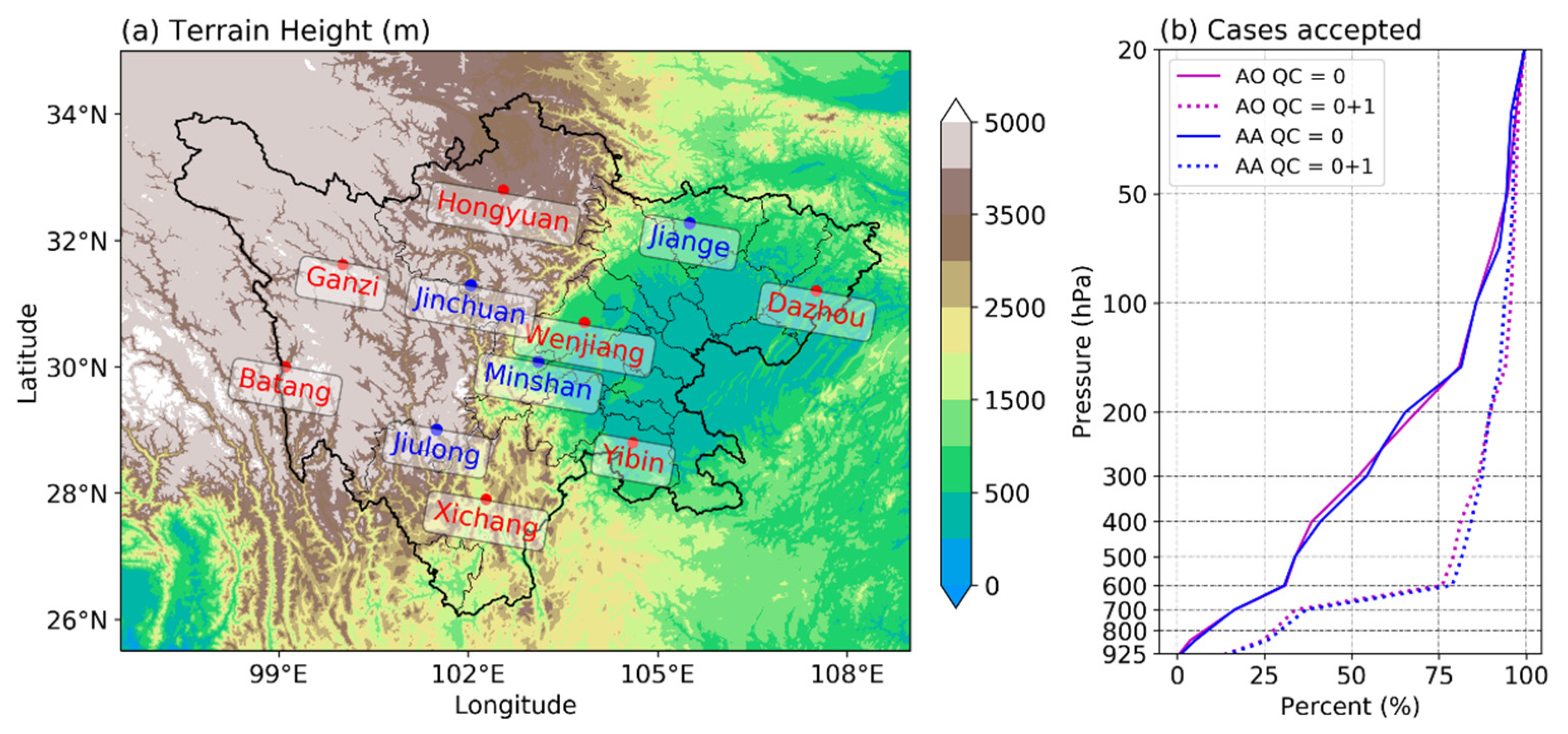
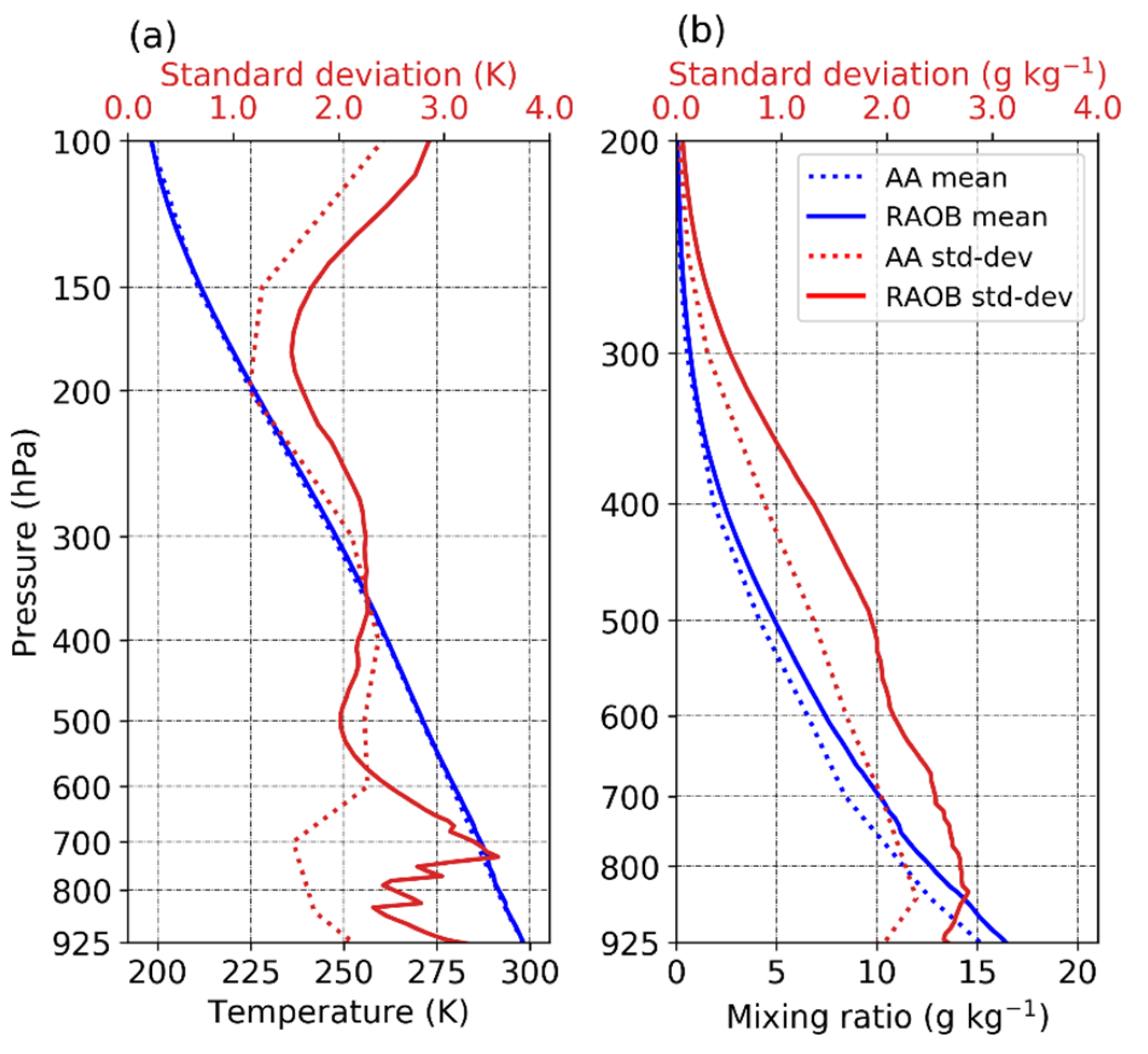
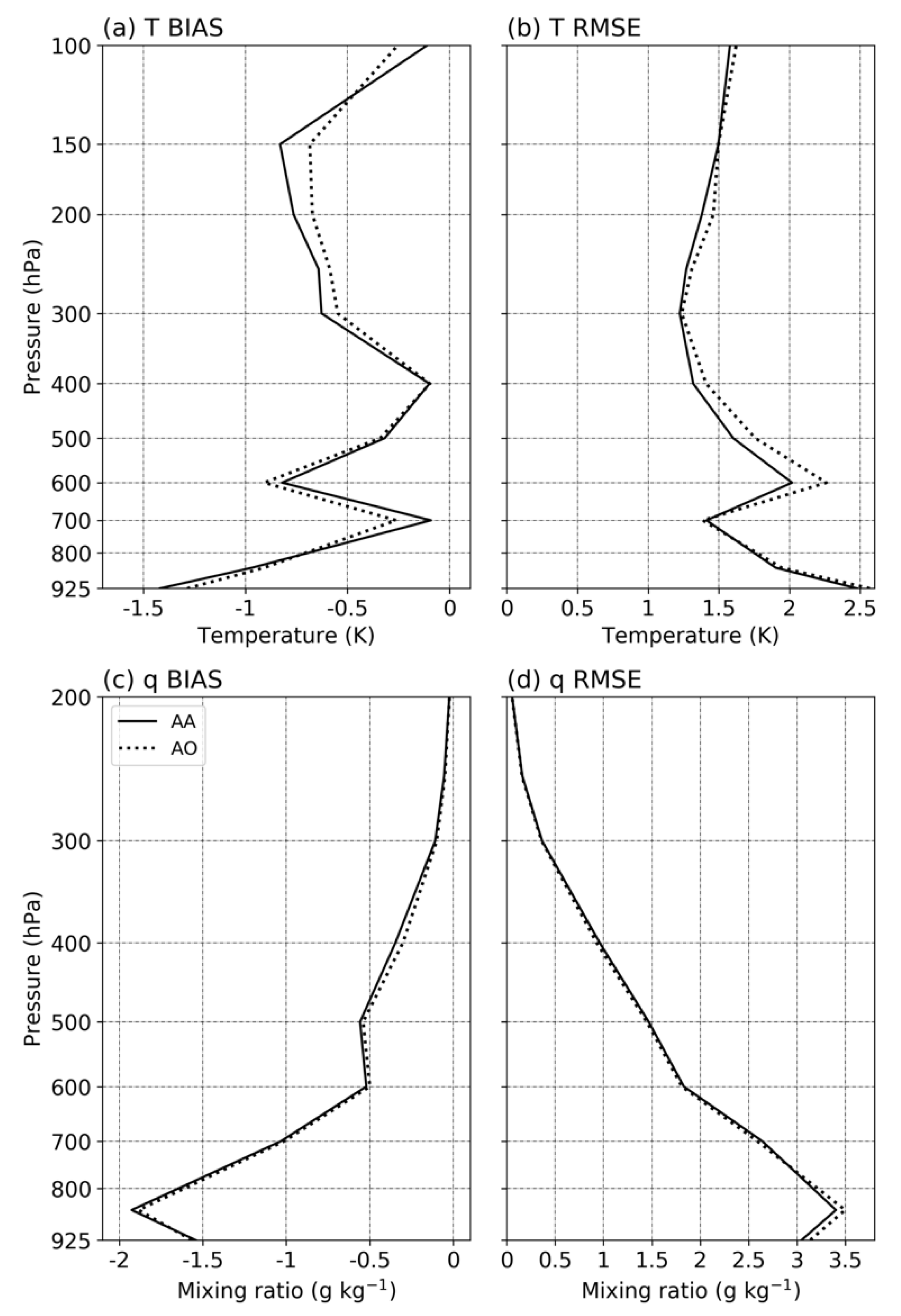
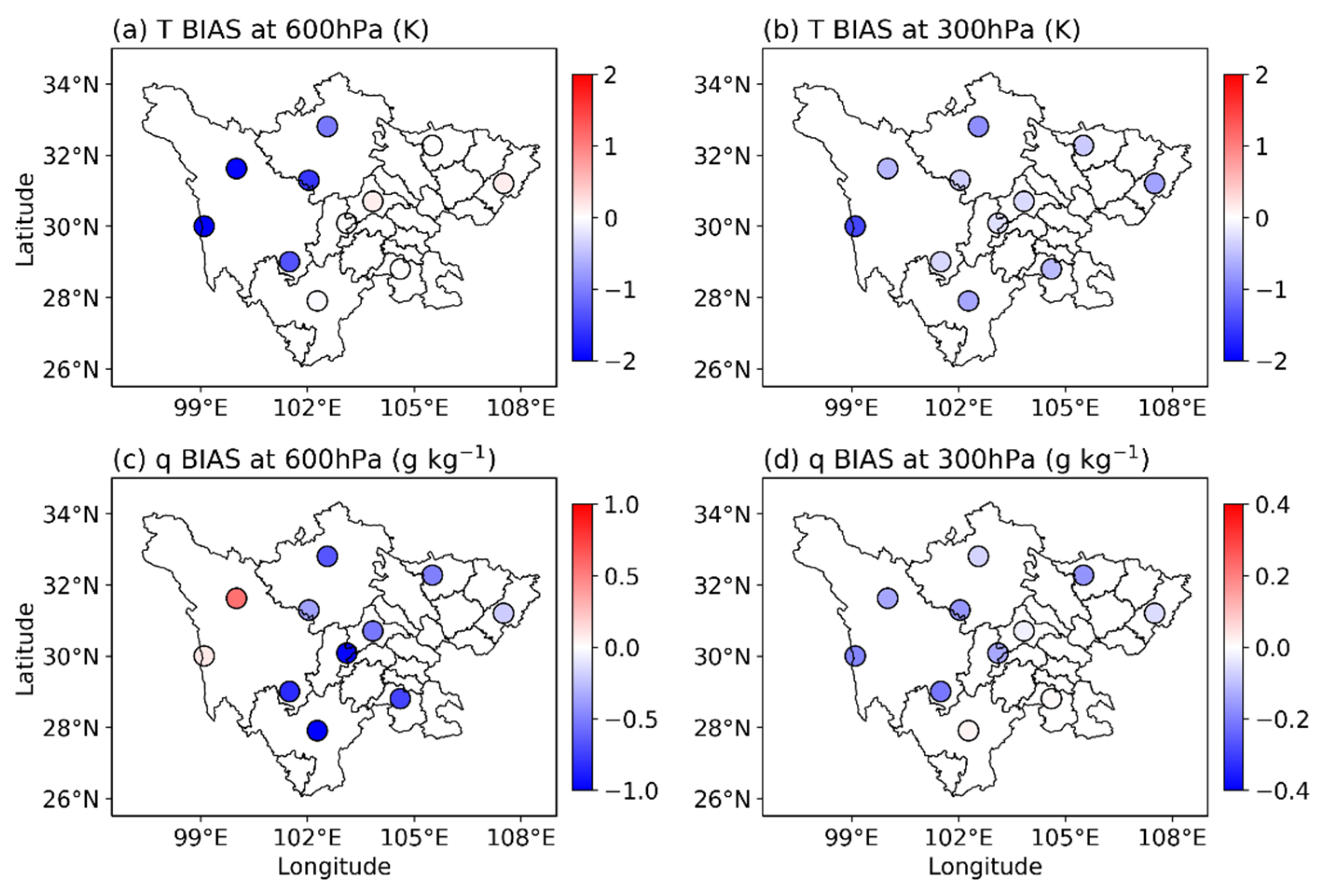
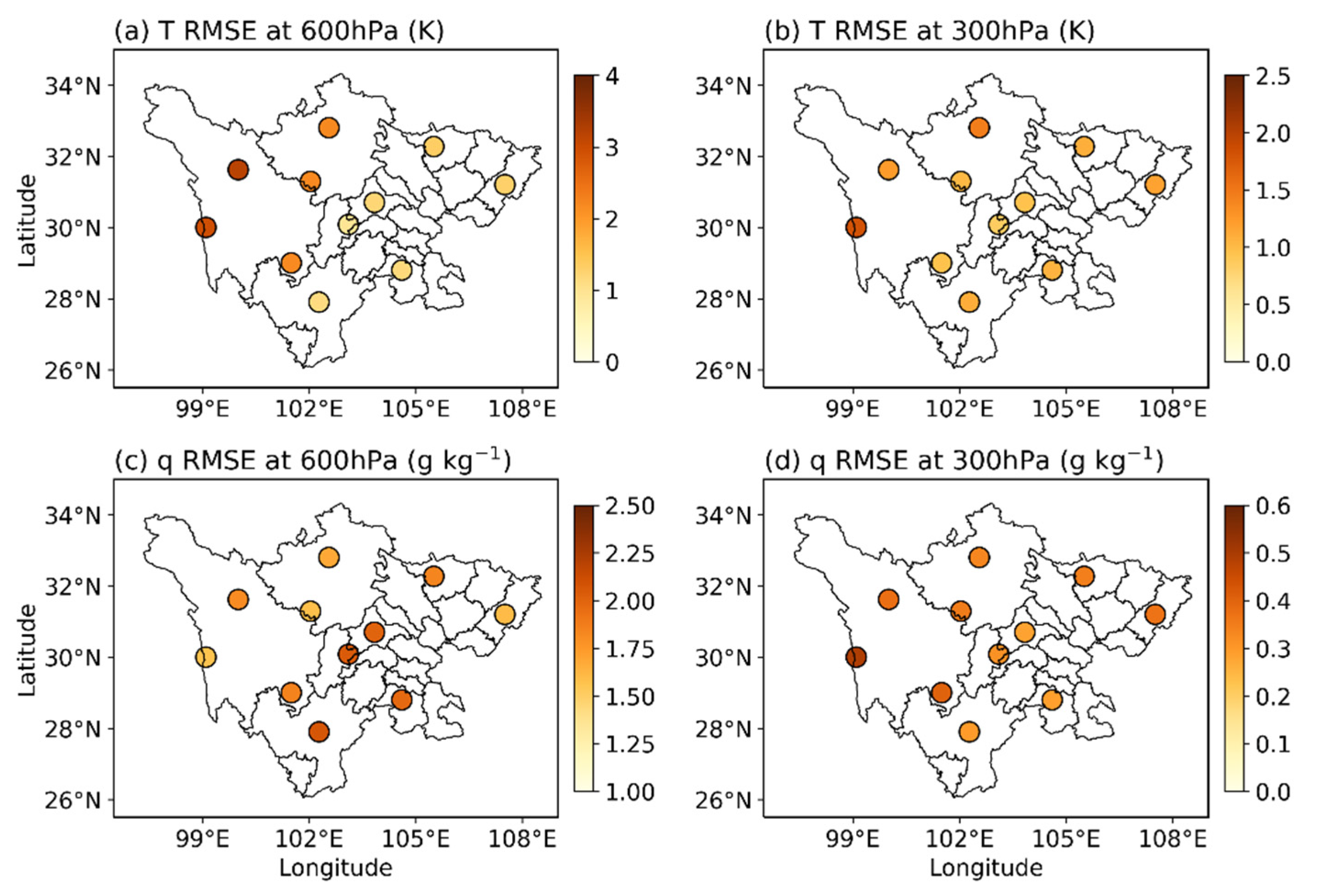
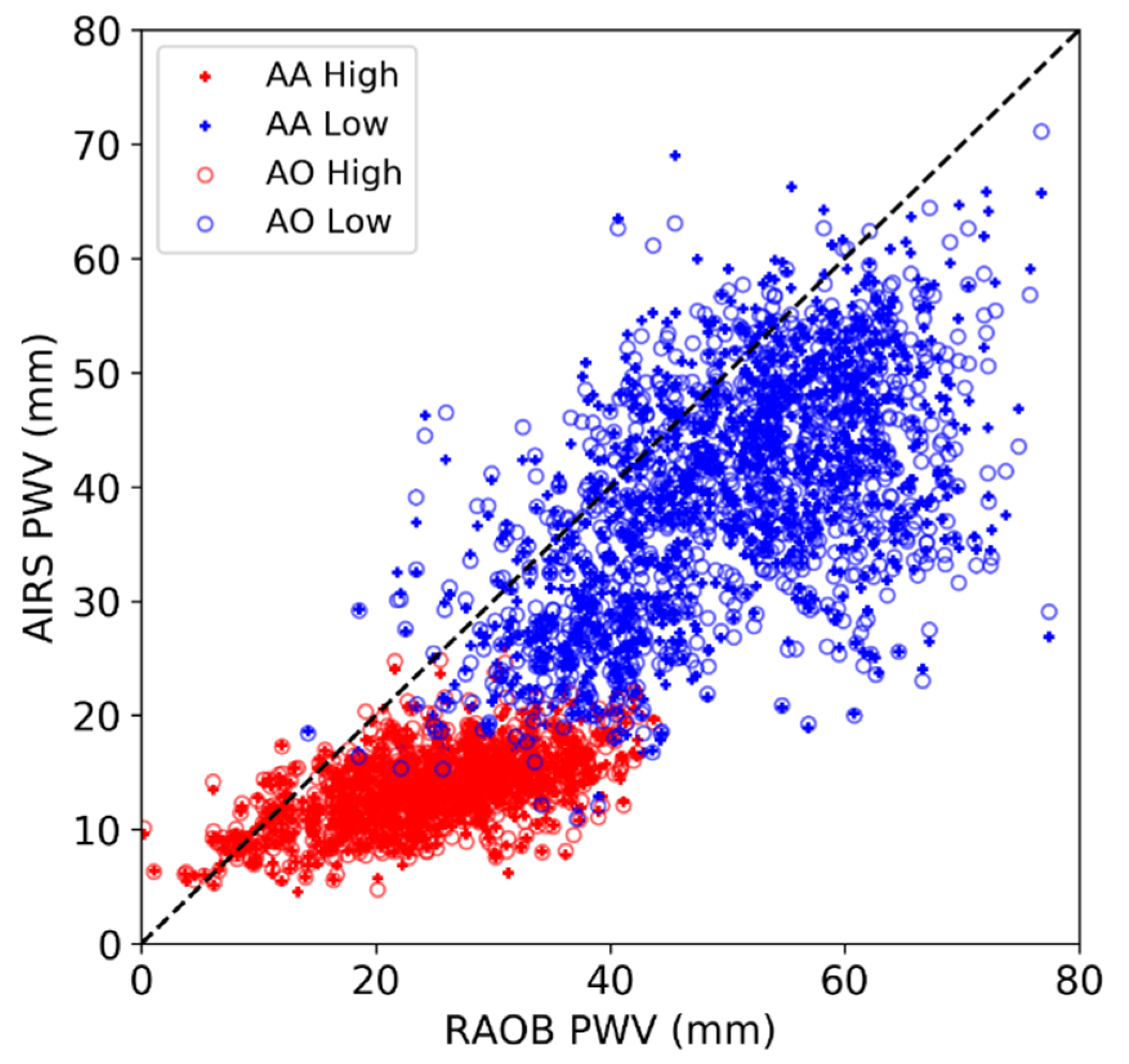
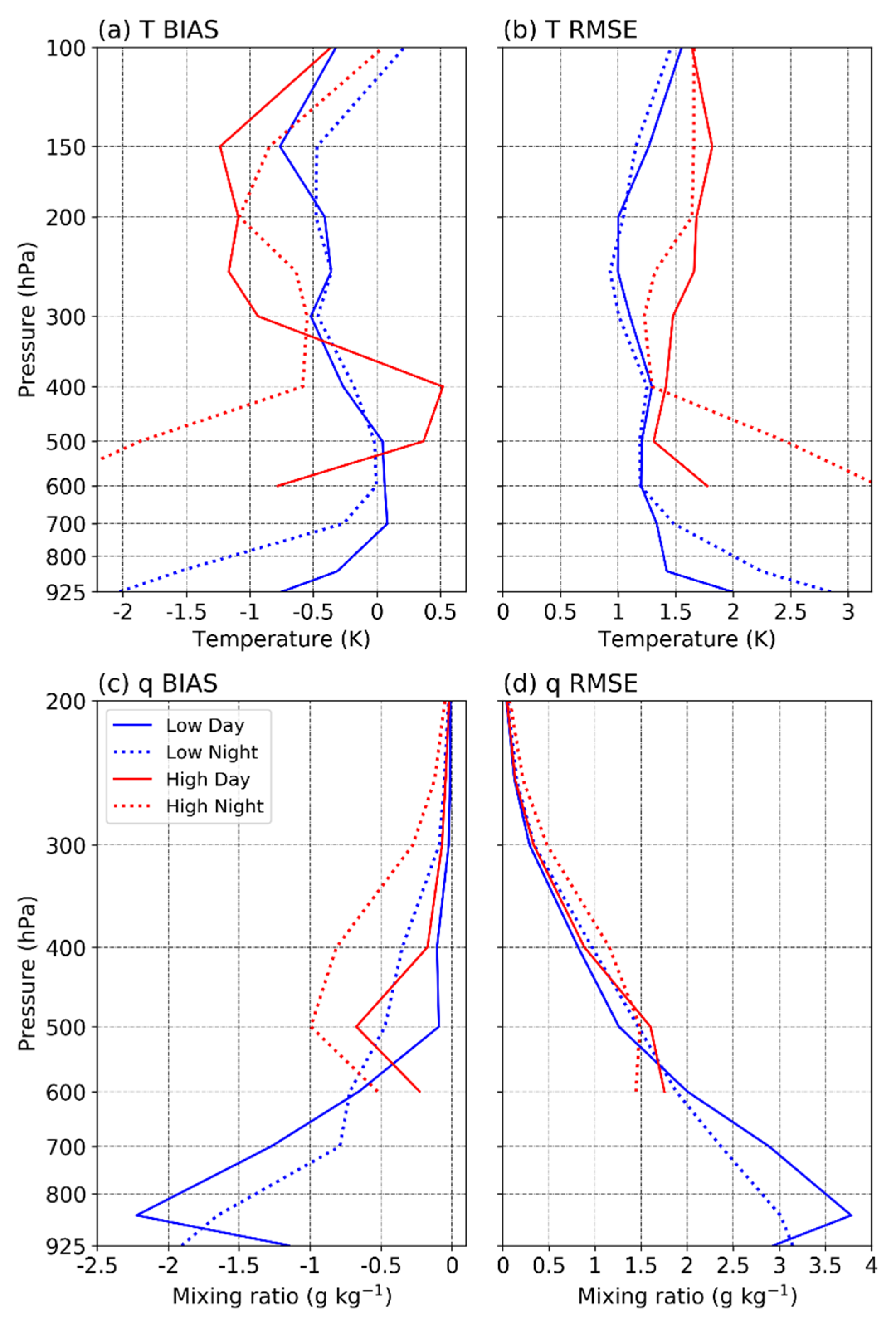
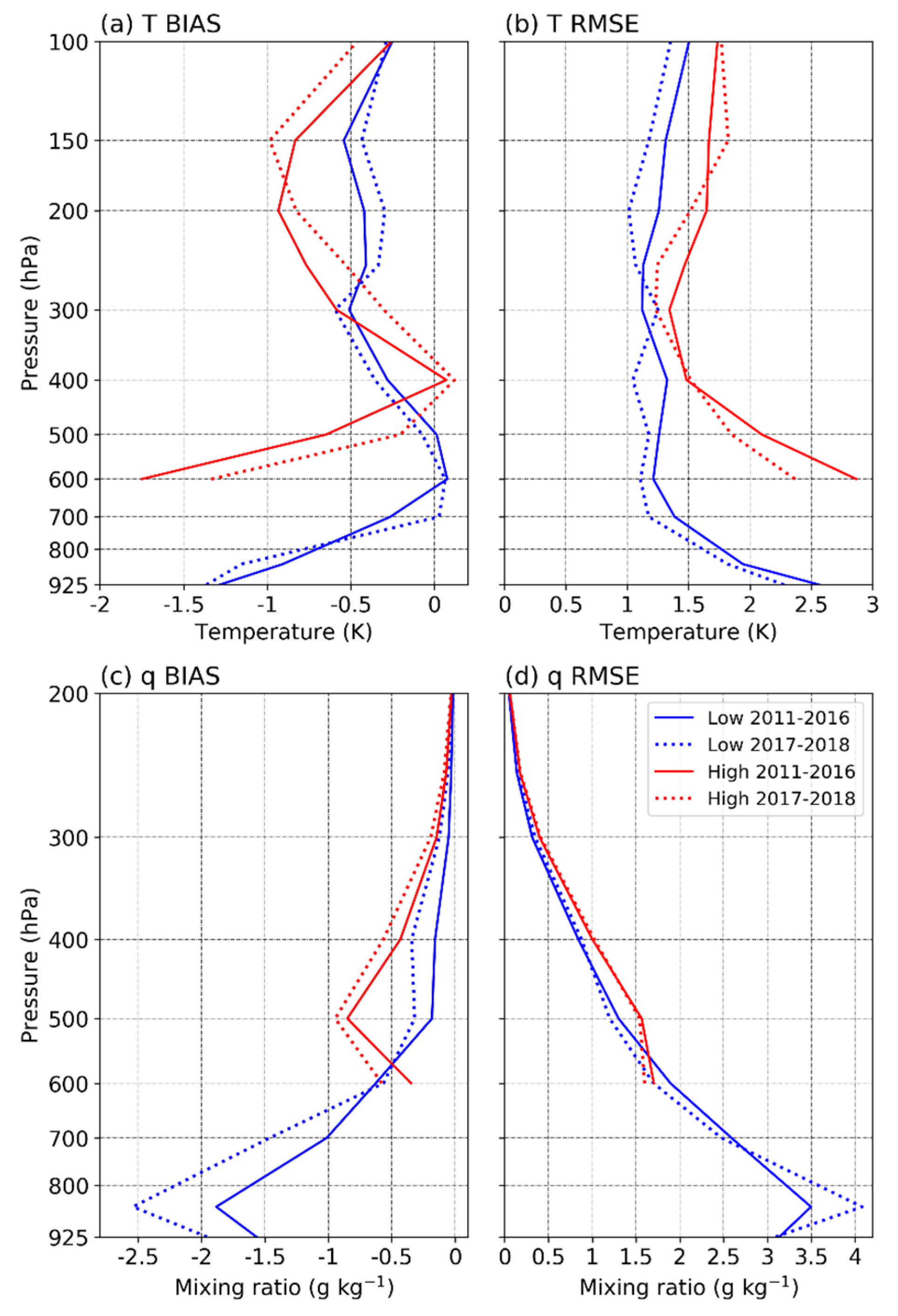
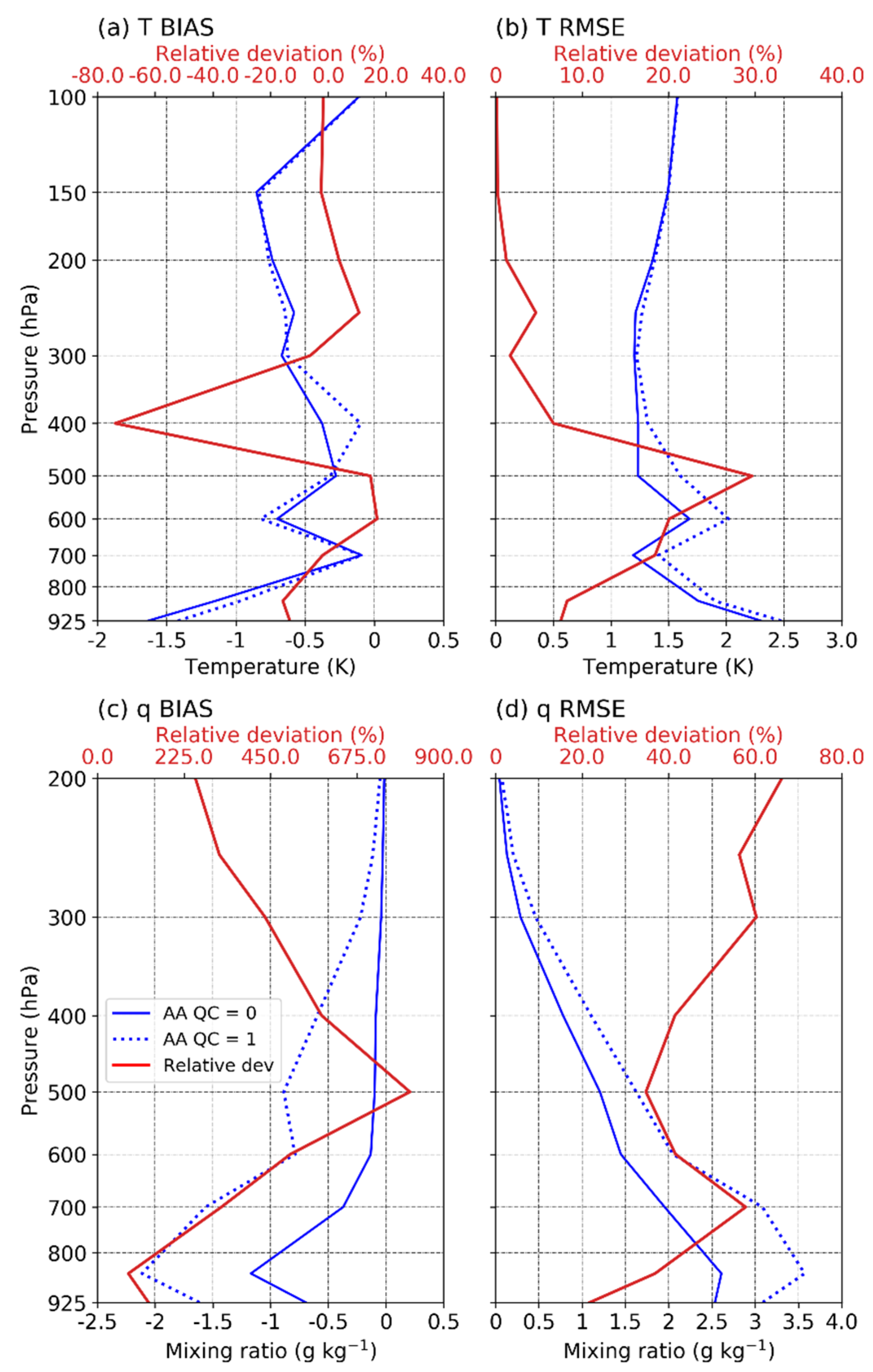
| Radiosonde Site | Latitude (°) | Longitude (°) | Height (m) |
|---|---|---|---|
| Batang | 30.00 | 99.10 | 2589 |
| Dazhou | 31.20 | 107.51 | 311 |
| Ganzi | 31.62 | 100.01 | 3394 |
| Hongyuan | 32.80 | 102.56 | 3422 |
| Jiange | 32.27 | 105.51 | 522 |
| Jinchuan | 31.29 | 102.04 | 2165 |
| Jiulong | 29.00 | 101.50 | 2919 |
| Minshan | 30.08 | 103.11 | 690 |
| Wenjiang | 30.70 | 103.84 | 541 |
| Xichang | 27.90 | 102.28 | 1592 |
| Yibin | 28.80 | 104.61 | 342 |
| Data Groups | Slope | Intercept | r | RMSE |
|---|---|---|---|---|
| AA High | 0.22 | 8.08 | 0.55 | 13.05 |
| AA Low | 0.56 | 11.36 | 0.58 | 14.26 |
| AO High | 0.22 | 8.01 | 0.55 | 13.04 |
| AO Low | 0.51 | 13.01 | 0.55 | 14.99 |
© 2019 by the authors. Licensee MDPI, Basel, Switzerland. This article is an open access article distributed under the terms and conditions of the Creative Commons Attribution (CC BY) license (http://creativecommons.org/licenses/by/4.0/).
Share and Cite
Heng, Z.; Jiang, X. An Assessment of the Temperature and Humidity of Atmospheric Infrared Sounder (AIRS) v6 Profiles Using Radiosonde Data in the Lee of the Tibetan Plateau. Atmosphere 2019, 10, 394. https://doi.org/10.3390/atmos10070394
Heng Z, Jiang X. An Assessment of the Temperature and Humidity of Atmospheric Infrared Sounder (AIRS) v6 Profiles Using Radiosonde Data in the Lee of the Tibetan Plateau. Atmosphere. 2019; 10(7):394. https://doi.org/10.3390/atmos10070394
Chicago/Turabian StyleHeng, Zhiwei, and Xingwen Jiang. 2019. "An Assessment of the Temperature and Humidity of Atmospheric Infrared Sounder (AIRS) v6 Profiles Using Radiosonde Data in the Lee of the Tibetan Plateau" Atmosphere 10, no. 7: 394. https://doi.org/10.3390/atmos10070394
APA StyleHeng, Z., & Jiang, X. (2019). An Assessment of the Temperature and Humidity of Atmospheric Infrared Sounder (AIRS) v6 Profiles Using Radiosonde Data in the Lee of the Tibetan Plateau. Atmosphere, 10(7), 394. https://doi.org/10.3390/atmos10070394




